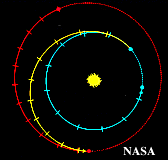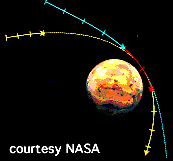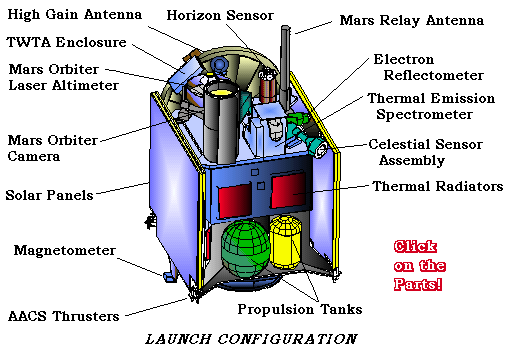 The MGS probe will leave the (blue) Earth orbit and move along the (yellow) transfer orbit
until it reaches
the (red) martian orbit next fall. All this time the probe is orbiting the Sun.
The MGS probe will leave the (blue) Earth orbit and move along the (yellow) transfer orbit
until it reaches
the (red) martian orbit next fall. All this time the probe is orbiting the Sun.
 The MGS probe will leave the (blue) Earth orbit and move along the (yellow) transfer orbit
until it reaches
the (red) martian orbit next fall. All this time the probe is orbiting the Sun.
The MGS probe will leave the (blue) Earth orbit and move along the (yellow) transfer orbit
until it reaches
the (red) martian orbit next fall. All this time the probe is orbiting the Sun.
Click on the orbit transfer picture on the left to see a larger image of the orbit transfer with the relevant physics data.
 1. What would be the speed of the MGS probe if it were to
stay in the same
orbit as the Earth (the blue orbit in the picture?) Note the position of Mars as the probe
starts on its journey
towards it.
1. What would be the speed of the MGS probe if it were to
stay in the same
orbit as the Earth (the blue orbit in the picture?) Note the position of Mars as the probe
starts on its journey
towards it.
 Once the probe reaches its destination orbit it will be shifted into an orbit around Mars (the
"capture orbit"
drawn in yellow.) This is the MOI (Mars Orbit Insertion) phase of the mission.
Click on the MOI picture on the right to access the larger MOI picture with the relevant
physics data.
Once the probe reaches its destination orbit it will be shifted into an orbit around Mars (the
"capture orbit"
drawn in yellow.) This is the MOI (Mars Orbit Insertion) phase of the mission.
Click on the MOI picture on the right to access the larger MOI picture with the relevant
physics data.
Click here if you would like to see
the original page from which this excerpt comes.
Back to the top of this document
<
BR>
On Thursday, 7 Nov 1996, NASA launched a 10-month, unmanned mission to Mars, the first step in a multi-spacecraft bid to determine if there is -- or ever was -- life on the fourth rock from the sun.
Global Surveyor, the first of 10 NASA probes bound for Mars the next decade, replaces one that mysteriously disappeared three years ago.
Surveyor will take 10 months to make the 470-million-mile trip and another six months to ease into a mapping orbit. Later, it will dip into the Red Planet's thin atmosphere, using its wing-like solar panels as brakes.
Surveyor will study the Martian surface and atmosphere, but will not land.
Back to the Table of Contents
<
BR>
Here is a schematic of the Mars Global Surveyor, courtesy of NASA:

Back to the Table of Contents
<
BR>
 2.
2.  3.
3.  4.
4. 